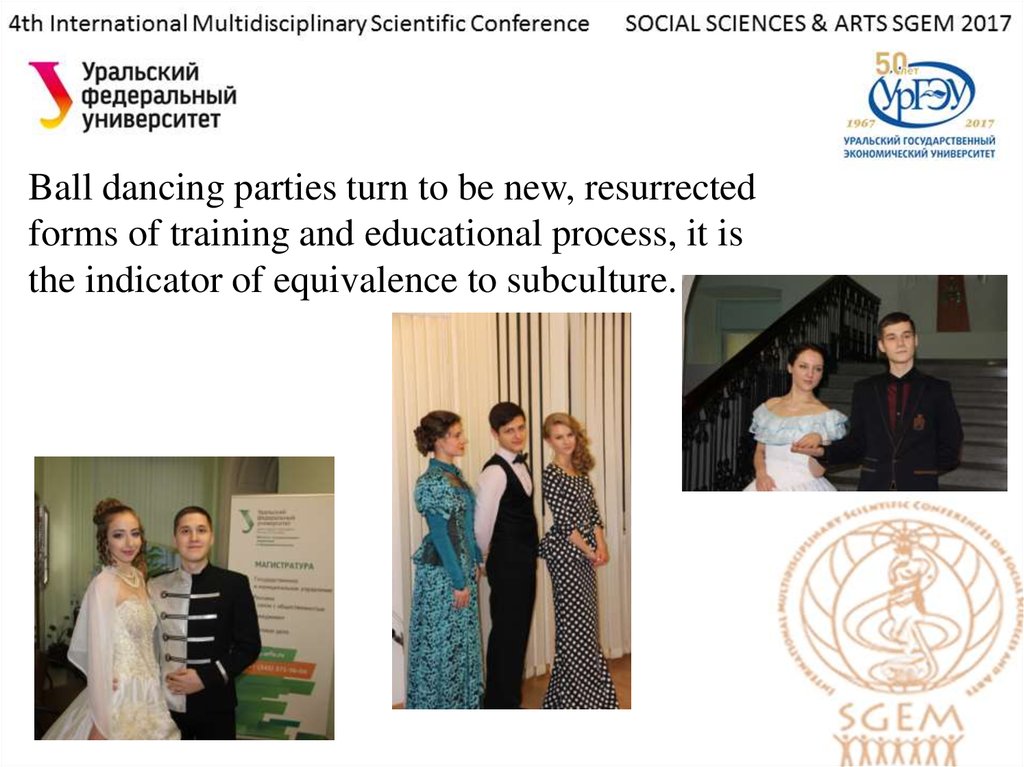Похожие презентации:
Traditions in education in opinions of students of university
1. TRADITIONS IN EDUCATION IN OPINIONS OF STUDENTS OF UNIVERSITY
Dr. Elena NarkhovaDr. Elena Korniltseva
Dr. Dmitry Narkhov
Dr. Igor Dobrynin
Dr. Irina Teslenko
2.
Heritage is central to all humankind andto any community.
Throughout millennia the distribution
of cultural background, necessary skills
were done by way of a tradition
3.
In a tradition as well as in other developments ofsocial life a historical link between new and old
on-going process of continuum and consistency is
true to take place.
At present the subject of conservation and
consolidation of the younger generation
cultural values appears to be currently
central more than ever.
4.
A young gentleman in a contemporaryfast-paced society by virtue of his
mobility, information freedom,
adaptability of perception, play the
center part as a critic, a founder, a
keeper and a recipient of culture.
5.
Some issues of self-cultural identity, thecorrelation of global and national become
not just front and center but seminal for
everybody.
Education at university level qualifies in
volume professionals for variety of spheres
and industries.
Present-day students in their turn specify
social and cultural features of their society.
6.
In conditions of anomie and the changesof the basic cultural traditions university
students’ opinion poll study about their
views on society basic traditions is of
great importance.
7.
Those basic traditions help students to preservethe vital sophistication of previous generations,
national identity in the age of globalization.
The key method of research was the
expert-based examining interview.
8.
Junior students of the 3d year of studyspecialty “State and municipal management”
were the experts.
The students’ estimation is essential to us as
long as they are to shape policy in the country
in future.
9.
The research objective involved the students’opinion research about the ball dancing parties
as traditional form of leisure activity of their
predecessors’ subculture.
10.
A ball dancing party was a unique socialexamination for social elite at the times of
Imperial Russia.
11.
“The imperial ball dancing party” of students came about as aninnovative training technology of business communication and
was taken to advantage as the empirical basis of the research.
12.
The subject matter of the ball dancingparty was founded on Russian historical
and cultural traditions and also indicated
the characteristic aspects of students’
speciality.
13.
14.
For the Sverdlovsk Region it is traditional to carry throughball dancing parties within system of vocational secondary
education among the students of Cadet schools.
In the present case a ball dancing party fully realizes the
idea to maintain an officer’s reputation, his military honour
and love of the beautiful.
15.
Ball dancing parties turn to be new, resurrectedforms of training and educational process, it is
the indicator of equivalence to subculture.
16.
The cooperative workmanship of teachers and students whilearranging and running ball dancing parties develops a flair to
cooperation, mutual intelligibility and creates an informal way
to get knowledge and skills across one generation to the other.
17.
The key outcome of a ball dancing party is thewell-developed atmosphere of good will,
collaboration, sense of entity, self-reflection and
self-identification.
The present data results are to be considered as
preservation of one of the fundamentals of a
classical university of humanitarian focused
ideology.
The university ball dancing parties arrangement
traditions serve as an example of traditions recreation.
18.
Images:Yandex picture https://yandex.ru/images/
Social network Vkontakte
https://vk.com/bal_urfu
Personal photos of authors
19.
Contacts:e_narkhova@mail.ru
kornilceva.e@ya.ru
d_narkhov@mail.ru
dobry-66@mail.ru
iv_k@mail.ru
Thank you for attention!



















 Образование
Образование








